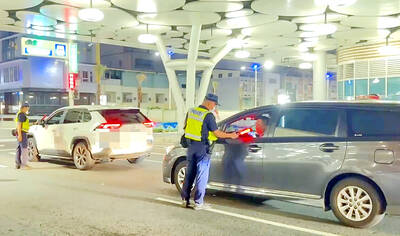Formosat-3, a weather satellite constellation jointly developed by Taiwan and the US, is to complete its 10th year of operations next month, and a follow-on program will be launched by the end of this year to replace the aging system, Taiwan’s National Space Organization said.
The system — a constellation of six small satellites — was launched on April 15, 2006, and is the first large-scale space collaboration between Taiwan and the US, where the project is known as the Constellation Observing System for Meteorology, Ionosphere and Climate (COSMIC).
The constellation has taken more than 10 million soundings — vertical profiles of the atmosphere — since its launch and the data were provided real-time free of charge to more than 3,000 researchers and weather forecasters in 83 nations, the agency said.
According to the European Centre for Medium-Range Weather Forecasts, Formosat-3 was ranked No. 5 in 2012 among all Earth-observing systems in the world in terms of its ability to help accurately predict weather, reducing the error margin of forecasts by as much as 10 percent, the agency said.
Other than Taiwan’s Central Weather Bureau, major weather forecast centers and agencies around the world, including those in Canada, the US, Japan, Australia, South Korea, Britain and other European countries, have incorporated the data provided by Formosat-3 into their weather forecasting systems, the agency said.
“Data collected by Formosat-3 are especially useful for forecasting typhoons, which is particularly beneficial for Taiwan. Formosat-3 is able to provide accurate observations of water vapor, the ‘fuel’ that allows typhoons to grow, in high vertical resolution. Hence, Formosat-3 has been called ‘the most accurate space thermometer,’” University Corporation for Atmospheric Research community programs director Bill Kuo (郭英華) said.
In its initial stages, the constellation could provide 2,400 pieces of data every day, but now it can only provide 650 pieces of data, as a satellite failed and was decommissioned in 2010 and other satellites have aged, agency Director Chang Guey-shin (張桂祥) said, adding that he was pleased to see that the system has far exceeded its original planned five-year mission and continues to operate into its 10th year and beyond.
Taiwan and the US are collaborating on a follow-up mission, Formosat-7, or COSMIC-2, which consists of 12 mission-specific satellites plus one agency-built satellite, which should be able to collect five times as much data as Formosat-3, Chang said.
The 12 satellites are to be deployed in two clusters of six satellites, in low and high-inclination orbits, by the end of this year and in 2018 respectively, Chang said.

TRAFFIC SAFETY RULES: A positive result in a drug test would result in a two-year license suspension for the driver and vehicle, and a fine of up to NT$180,000 The Ministry of Transportation and Communications is to authorize police to conduct roadside saliva tests by the end of the year to deter people from driving while under the influence of narcotics, it said yesterday. The ministry last month unveiled a draft of amended regulations governing traffic safety rules and penalties, which included provisions empowering police to conduct mandatory saliva tests on drivers. While currently rules authorize police to use oral fluid testing kits for signs of drug use, they do not establish penalties for noncompliance or operating procedures for officers to follow, the ministry said. The proposed changes to the regulations require

The Executive Yuan yesterday announced that registration for a one-time universal NT$10,000 cash handout to help people in Taiwan survive US tariffs and inflation would start on Nov. 5, with payouts available as early as Nov. 12. Who is eligible for the handout? Registered Taiwanese nationals are eligible, including those born in Taiwan before April 30 next year with a birth certificate. Non-registered nationals with residence permits, foreign permanent residents and foreign spouses of Taiwanese citizens with residence permits also qualify for the handouts. For people who meet the eligibility requirements, but passed away between yesterday and April 30 next year, surviving family members

Taipei, New Taipei City, Keelung and Taoyuan would issue a decision at 8pm on whether to cancel work and school tomorrow due to forecasted heavy rain, Keelung Mayor Hsieh Kuo-liang (謝國樑) said today. Hsieh told reporters that absent some pressing reason, the four northern cities would announce the decision jointly at 8pm. Keelung is expected to receive between 300mm and 490mm of rain in the period from 2pm today through 2pm tomorrow, Central Weather Administration data showed. Keelung City Government regulations stipulate that school and work can be canceled if rain totals in mountainous or low-elevation areas are forecast to exceed 350mm in

China Airlines Ltd (CAL) yesterday morning joined SkyTeam’s Aviation Challenge for the fourth time, operating a demonstration flight for “net zero carbon emissions” from Taiwan Taoyuan International Airport to Bangkok. The flight used sustainable aviation fuel (SAF) at a ratio of up to 40 percent, the highest proportion CAL has achieved to date, the nation’s largest carrier said. Since April, SAF has become available to Taiwanese international carriers at Taipei International Airport (Songshan airport), Kaohsiung International Airport and Taoyuan airport. In previous challenges, CAL operated “net zero carbon emission flights” to Singapore and Japan. At a ceremony at Taoyuan airport, China Airlines chief sustainability